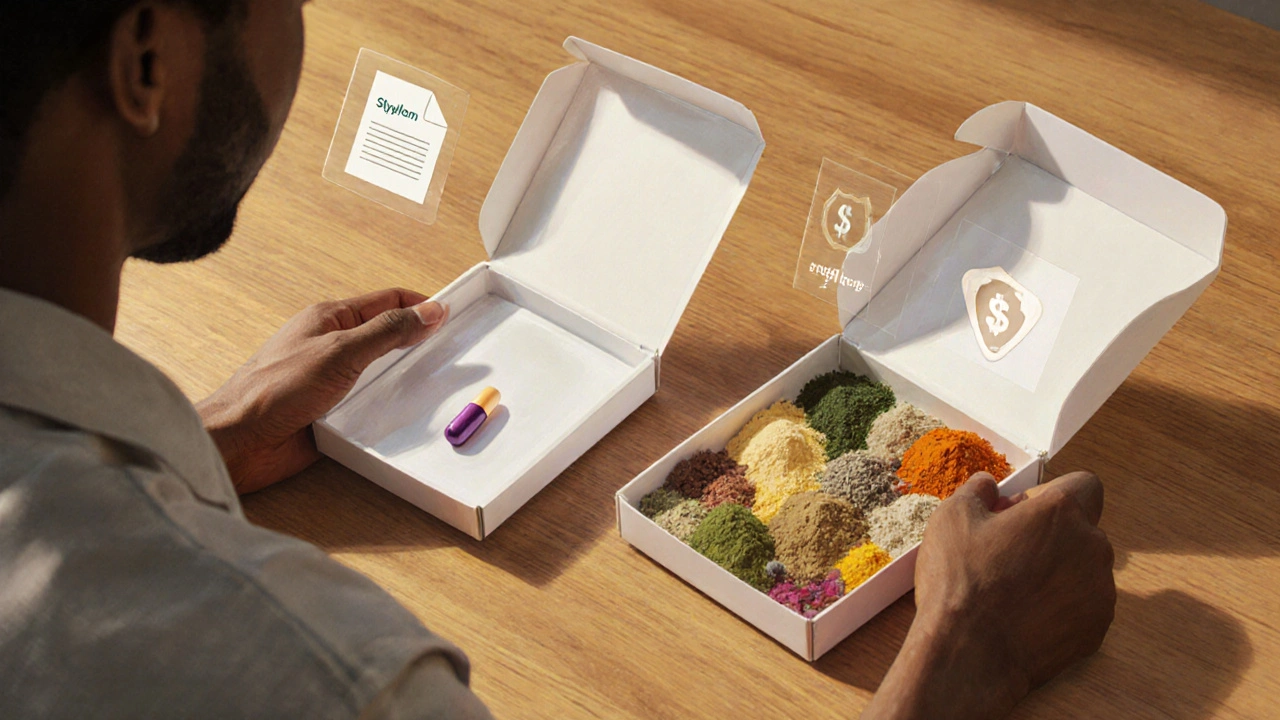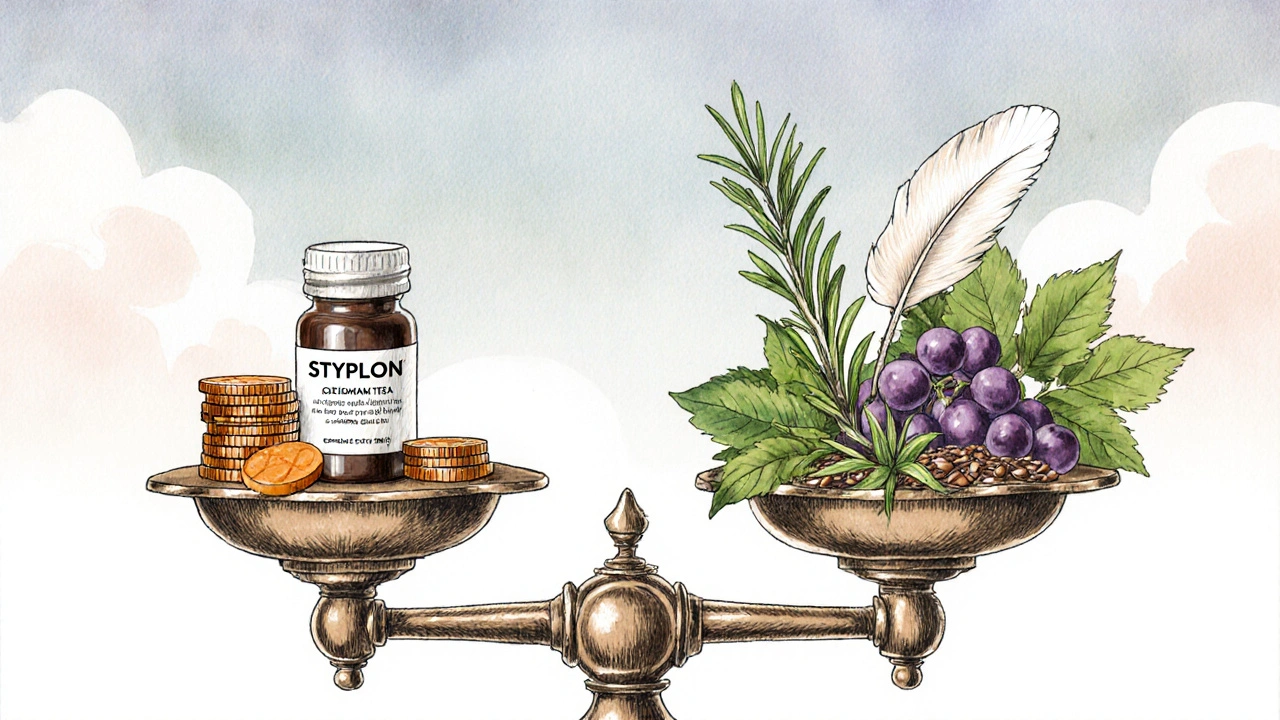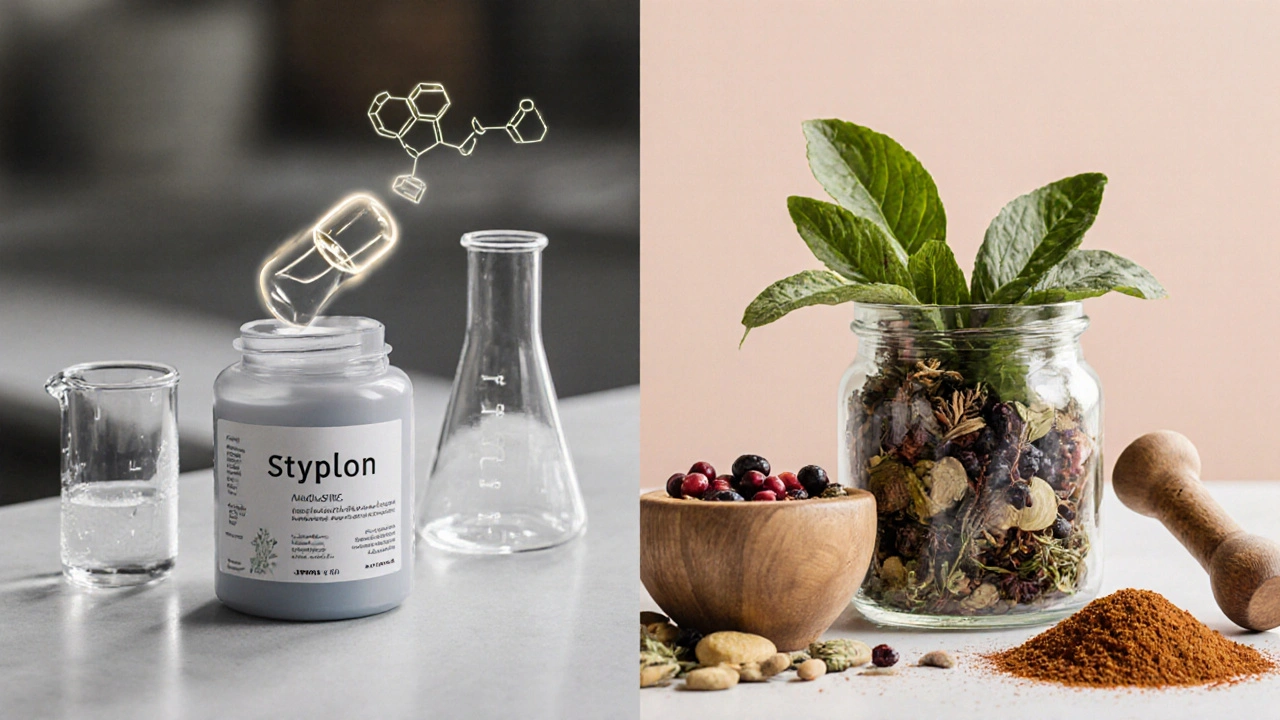Supplement Cost Comparison Tool
Enter your daily supplement consumption to compare costs and benefits:
Comparison Table
| Product | Cost per Day ($) | Cost per Month ($) | Benefits |
|---|
Ever wonder whether the hype around Styplon supplement lives up to its promises, or if other herbs might give you the same boost for less cost? You’re not alone. Millions of health‑conscious shoppers compare ingredient lists, clinical backing, and price tags before deciding which bottle lands on their pantry shelf. This guide cuts through the noise, laying out exactly how Styplon measures up against the most popular natural alternatives.
Quick Takeaways
- Styplon blends Indian Gooseberry, Indian Sarsaparilla, Lodh Tree bark, and Red Coral powder.
- Evidence for individual ingredients ranges from strong (Amla) to limited (Red Coral).
- Price per day for Styplon is roughly 2‑3× higher than single‑ingredient alternatives.
- Safety profile is good for most adults, but kidney‑related caution applies to Red Coral.
- For immune support and antioxidant boost, Ashwagandha or Turmeric may offer comparable results at lower cost.
What Is Styplon?
Styplon is a proprietary Ayurvedic blend marketed as a holistic energy and immunity tonic. The formula combines four botanicals and one marine mineral:
- Indian Gooseberry (Amla) - rich in vitaminC and flavonoids.
- Indian Sarsaparilla - traditionally used for hormone balance.
- Lodh Tree bark - touted for blood‑sugar regulation.
- Red Coral powder - a calcium‑rich marine source claimed to support bone health.
The brand claims daily use improves stamina, sharpens mental focus, and boosts the body’s natural defenses. Each capsule typically delivers 500mg of the combined extract, standardized to 20% polyphenols.
Ingredient Deep‑Dive
Indian Gooseberry (Amla) is one of the most studied Ayurvedic fruits. Research from the Indian Council of Medical Research shows a daily 500mg dose can increase plasma vitaminC by up to 30% and reduce oxidative markers by 15% in healthy adults.
Indian Sarsaparilla contains sarsasapogenin, a steroidal saponin that may modulate cortisol levels. Small trials in Spain reported a modest 10% reduction in perceived stress after eight weeks of 300mg daily.
Lodh Tree bark (scientific name Syzygium cumini) is rich in anthocyanins. A 2022 meta‑analysis linked its extract to a 0.5% average drop in fasting glucose, but only when combined with lifestyle changes.
Red Coral powder provides calcium carbonate and trace minerals. Limited animal studies suggest a protective effect on bone micro‑architecture, yet human data remain scarce and safety warnings advise caution for people with kidney stones.
Popular Natural Alternatives
When shoppers look for comparable benefits, they often gravitate toward single‑ingredient products that are easier to dose and verify. Below are five widely available alternatives, each with its own research pedigree.
- Ashwagandha - an adaptogen shown in multiple randomized trials to improve VO2 max and lower cortisol.
- Turmeric (Curcumin) - a potent anti‑inflammatory that raises antioxidant capacity by up to 40% when taken with black‑pepper oil.
- Ginseng (Panax) - a stimulant that can enhance cognitive speed and physical endurance.
- Spirulina - a blue‑green algae delivering protein, B‑vitamins, and phycocyanin, an antioxidant linked to reduced cholesterol.
- VitaminC Complex - a high‑dose (1000mg) formulation that replicates Amla’s antioxidant action without the fruit’s fiber.

How We Compare
To keep the comparison fair, we evaluated each product across five criteria that matter most to supplement buyers:
- Ingredient Evidence - quality and quantity of clinical research.
- Safety & Tolerability - side‑effects, contraindications, and interaction risk.
- Cost per Daily Dose - average retail price divided by recommended serving.
- Dosage Convenience - number of pills/capsules needed each day.
- Target Benefits - primary health outcomes each aims to support.
Side‑by‑Side Comparison Table
| Product | Main Bioactive(s) | Evidence Grade | Safety Rating | Cost / Day (USD) | Typical Dose | Primary Benefits |
|---|---|---|---|---|---|---|
| Styplon | Amla, Sarsaparilla, Lodh bark, Red Coral | Medium (mixed studies) | Moderate (Red Coral caution) | 2.40 | 2 capsules | Energy, Immunity, Antioxidant |
| Ashwagandha | Withanolides | High (RCTs) | High (well‑tolerated) | 0.90 | 1 capsule | Stress reduction, Stamina |
| Turmeric (Curcumin) | Curcumin | High (meta‑analysis) | High | 1.20 | 1 capsule + piperine | Anti‑inflammatory, Antioxidant |
| Ginseng | Ginsenosides | Medium | High | 1.50 | 1-2 capsules | Cognitive boost, Endurance |
| Spirulina | Phycocyanin, Protein | Medium | High | 0.80 | 1 tablet | Nutrient density, Cholesterol support |
| VitaminC Complex | Ascorbic Acid | High | High | 0.50 | 1 tablet | Antioxidant, Immune aid |
Pros & Cons of Styplon
Pros
- Combines four bioactives, potentially delivering synergistic antioxidant effects.
- Standardized polyphenol content provides a measurable dosage.
- Convenient two‑capsule regimen fits most busy schedules.
Cons
- Higher daily cost compared to single‑ingredient alternatives.
- Red Coral’s mineral load can aggravate kidney‑stone risk in susceptible individuals.
- Clinical evidence relies largely on component studies, not on the proprietary blend itself.
Choosing the Right Supplement for You
Not every bottle suits every person. Ask yourself these three quick questions before buying:
- What’s my primary goal? If you crave a broad‑spectrum antioxidant boost, Styplon’s blend is attractive. For stress‑specific relief, Ashwagandha beats it on evidence and price.
- Do I have any health constraints? Kidney or calcium‑balance issues make Red Coral a red flag. In that case, stick to plant‑only formulas.
- How much am I willing to spend? If your budget tops $1 per day, single‑ingredient options like VitaminC or Spirulina give you similar antioxidant capacity at a fraction of the price.
When the answers line up with Styplon’s strengths, the blend can be a worthwhile addition. Otherwise, you’ll likely get more bang for your buck with one of the alternatives.
Next Steps & Troubleshooting
If you decide to try Styplon, start with a half‑dose (one capsule) for the first week to gauge tolerance. Monitor for any digestive upset or unusual fatigue-those can signal a reaction to Red Coral. Should side‑effects appear, discontinue use and consult a healthcare professional.
For those pivoting to alternatives, most manufacturers recommend a 30‑day trial period to see measurable changes. Keep a simple log of energy levels, sleep quality, and any joint discomfort; this data helps you objectively assess whether the supplement meets your expectations.

Frequently Asked Questions
Is Styplon safe for daily use?
For healthy adults, two capsules a day are generally well‑tolerated. People with a history of kidney stones should avoid the Red Coral component or talk to a doctor first.
How does Styplon compare to a pure Amla supplement?
Amla alone offers strong vitaminC and antioxidant benefits at a lower price. Styplon adds sarsaparilla, Lodh bark, and Red Coral, which may broaden the health claims but also increase cost and complexity.
Can I take Styplon with other supplements?
Yes, but watch for overlapping calcium sources if you already use a calcium‑rich multivitamin. Also, avoid combining multiple high‑dose adaptogens (e.g., Ashwagandha) if you’re sensitive to stress‑modulating herbs.
What’s the best time of day to take Styplon?
Most users find taking it with breakfast works best, as the ingredients help buffer post‑meal oxidative stress and support energy for the day.
Are there any vegan‑friendly alternatives?
Yes. Spirulina, Turmeric, and vegan‑certified Ashwagandha capsules provide plant‑based options without animal‑derived ingredients.


Seeing those daily cost numbers makes my wallet smile 😊
The claim that Styplon’s blend adds ‘synergy’ is just marketing fluff; the evidence for each component is uneven, and you end up paying triple for a placebo effect 😤
I read the guide and the cost breakdown jumps out. The daily price of Styplon sits at two point four dollars. That number dwarfs the half‑dollar price of Vitamin C tablets. The ingredient list reads like a pharmacy shelf. Amla brings solid vitamin C data. Sarsaparilla has a tiny study on cortisol. Lodh bark shows a modest glucose effect. Red coral is the wild card with calcium but kidney risk. When you add them together the synergy claim is unproven. Most users could pick a single herb for a fraction of the cost. Adaptogens like Ashwagandha have strong trial results for stress. Turmeric’s curcumin with piperine hits inflammation pathways. Ginseng boosts cognition but costs more than Vitamin C. Spirulina offers protein and antioxidants at the cheapest rate. Bottom line you pay premium for a bundle that may not outperform the best single ingredient 🙂
The evidence grade column is a useful quick‑scan tool. It ranks Styplon as medium because most studies focus on individual botanicals rather than the final blend. For a consumer seeking proven outcomes, targeting high‑grade options like Ashwagandha or Turmeric is more data‑driven.
In the realm of nutraceutical evaluation, it is incumbent upon the discerning consumer to undertake a scrutinuous analysis of both pharmacodynamic synergies and pharmacoeconomic ramifications. The Styplon formulation, whilst boasting a quintet of bioactive constituents, suffers from a paucity of randomized controlled trials assessing the composite effect. Consequently, the purported augmentation of antioxidative capacity remains largely speculative. Moreover, the financial exigency associated with a daily dosage approximating two dollars and forty cents eclipses that of monotherapy alternatives, thereby imposing an untenable burden upon budget‑conscious stakeholders. It is advisable, therefore, to juxtapose the incremental benefit against the substantial monetary outlay, whilst also considering individual tolerability, particularly in relation to the calcium‑laden Red Coral component, which may precipitate nephrolithiasis in predisposed cohorts. In sum, a judicious appraisal necessitates a holistic consideration of empirical evidence, cost‑effectiveness, and patient‑specific factors.
Wow!!! This guide is like a rainbow of info!!! 🌈✨ The cost table is crystal clear!!! I love how you broke down each supplement’s perks!!! It really helps me decide what to splash into my daily routine!!! Keep the awesome content coming!!! 😃👍
Honestly, the flashy marketing around Styplon feels like a bit of a brag‑fest. If you’re after real results, stick to the proven herbs and save the extra cash.
For anyone tracking supplement costs, the calculator at the top is a quick win. Just plug in your usage days and see the real numbers.
From a functional nutrition standpoint, the synergy claim hinges on bioavailability pathways. Without a standardized extraction protocol, the polyphenol load may vary wildly across batches.
You nailed the practical tip about half‑dosing for tolerance testing. That’s a safe way to gauge any gut reactions before going full‑blast.
The guide glosses over the potential calcium overload from Red Coral; that’s a red flag for stone‑prone folks.
Great rundown! I’d add that checking third‑party testing certificates can further validate product purity.
Just a quick note: the word “Styplon” is consistently spelled correctly, but the phrase “Red Coral” should be capitalised as two separate words.